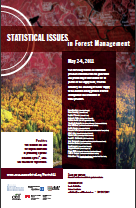Overview
(This workshop will take place at the Université Laval in Quebec City)
This workshop topic is embedded in a larger context of optimisation in the supply chain from the forest to the final market-ready product, a context presently being moved forward by a publicly-funded forest research network in Canada. The task at hand is to implement a new model of supply chain which relies on improvements in the generation and sharing of information among partners, and integration of such information for improving both efficiency and environmental performance in day-to-day operations. However, there is a disconnect between the error embedded in forest information and the cost imparted by this error to decision making along the supply chain. One of the main scientific challenges facing the scientific community is therefore to bridge this gap by quantifying and reducing uncertainty in forest information systems in conjunction with appropriate cost-benefits analysis for supply chain optimisation.
The workshop will focus on statistical issues related to the generation and the processing of information within the forest management system, along all phases of the supply chain, from forest inventory to timber supply analysis, and through to forest management decisions and the value of wood products. A special emphasis will be given to the quantification and the management of uncertainty throughout this process and to the value of uncertainty as information in decision making as applied to forestry. Two themes have been identified under which sub-themes can be further developed. The first is to deal with forest inventory, the second with decision making in forest management.
FOREST INVENTORY
The accurate estimation of forest resources over large geographic areas is a statistical problem. It is based on a survey that typically involves two phases of sampling. In the first phase, aerial photography has been the traditional method of data collection. Nowadays, remote sensing techniques based on the LIDAR (Light Detection and Ranging) laser technology, or on multispectral imaging from aircraft-mounted or satellite-borne sensors are available to collect the first phase data that give rough forest measurements. Such measurements can be combined with geophysical variables through a GIS (geographical information system). The second phase typically involves field visits of a small number of field plots to collect data on several variables including the basal area and the volume for all tree species found in the sampled plot.
The objective of this first workshop theme is to expand on the statistical techniques that have been proposed to combine the data from the two phases of the survey in order to benefit from the new technologies used for the first phase of data collection. The techniques to be investigated include model-based and design-based estimation procedures, non-parametric models and smoothing methods, spatial modeling and nearest neighbour imputation, and post-stratification.
DECISION MAKING IN FOREST MANAGEMENT
All forest management decisions, from the determination of harvest levels, to the harvest scheduling, and timing of supply to market-driven processing facilities, are based in whole or in part on forest-based information. Uncertainty in the forest-based information is seldom quantified and used as information per se, but yet generates inefficiencies in the supply chain. The corollary to this statement is that significant gains in efficiencies are possible in the supply chain through the wise use of uncertainty information.
The objective of this second workshop theme is therefore to explore new approaches to address the generation and use of information and its uncertainty for decision-making. These approaches may include Bayesian decision theory, as well as cost-plus-loss analysis, in which for example the expected losses due to suboptimal decisions caused by inaccurate data are added to the total costs of the forest inventory. Also of importance is the issue of timeliness of information, or the degradation of information usefulness over time, as the forest supply chain has to deal with increasingly volatile global markets.

